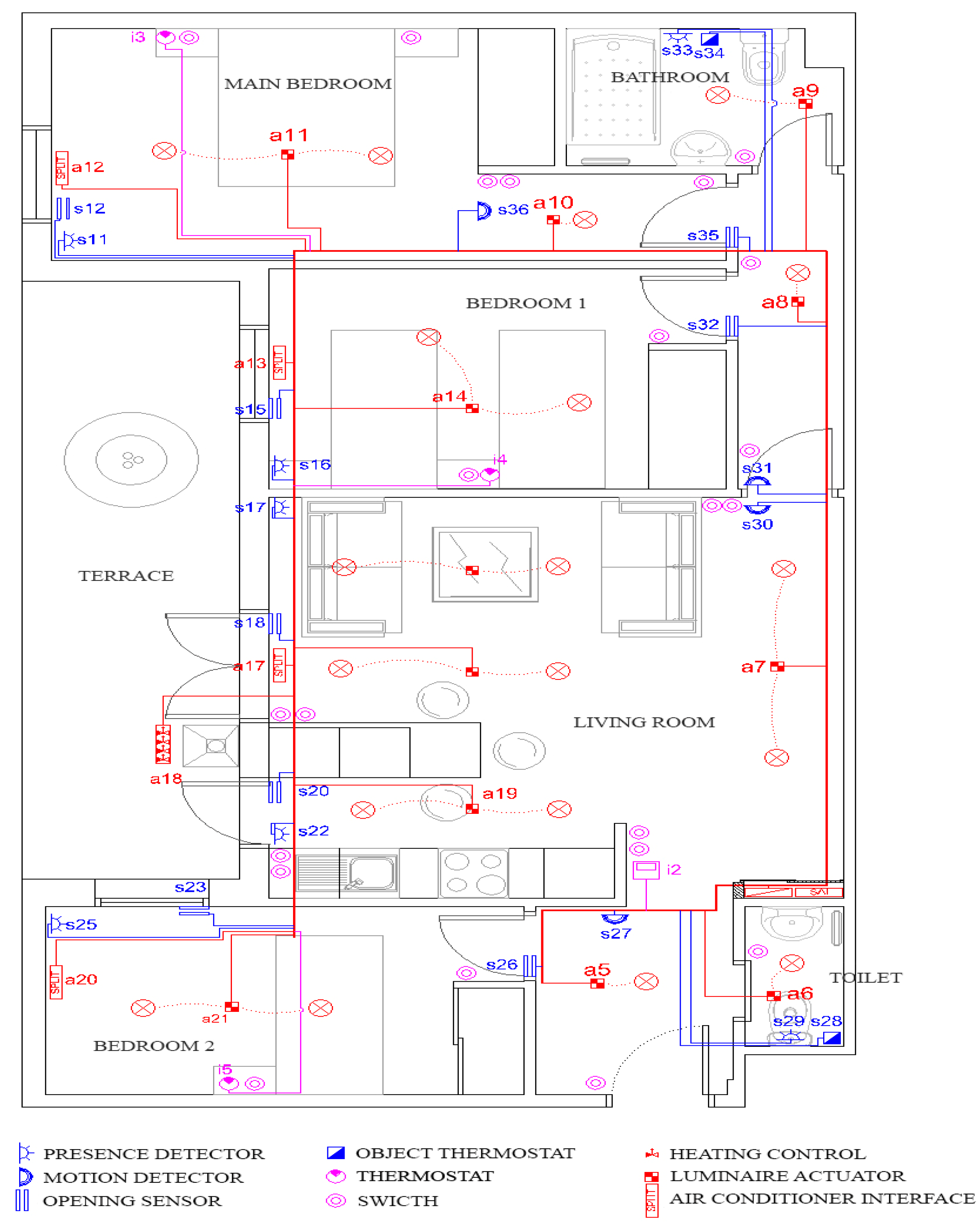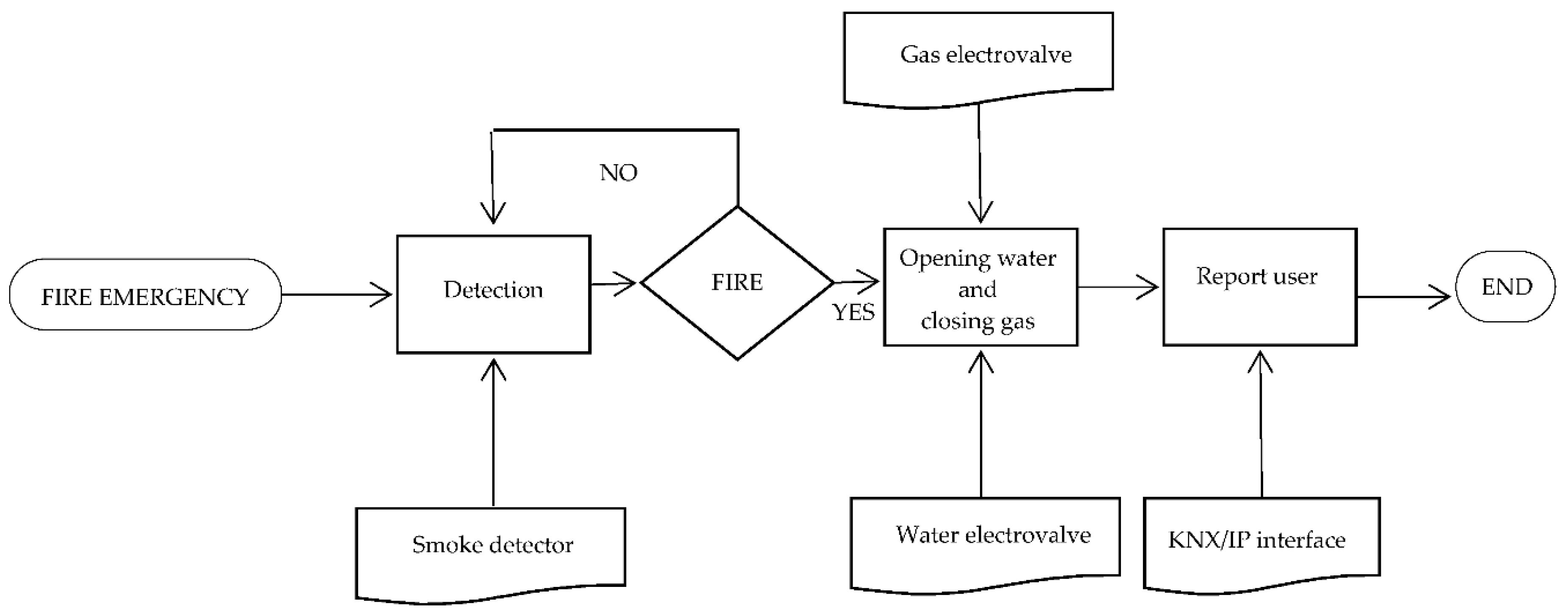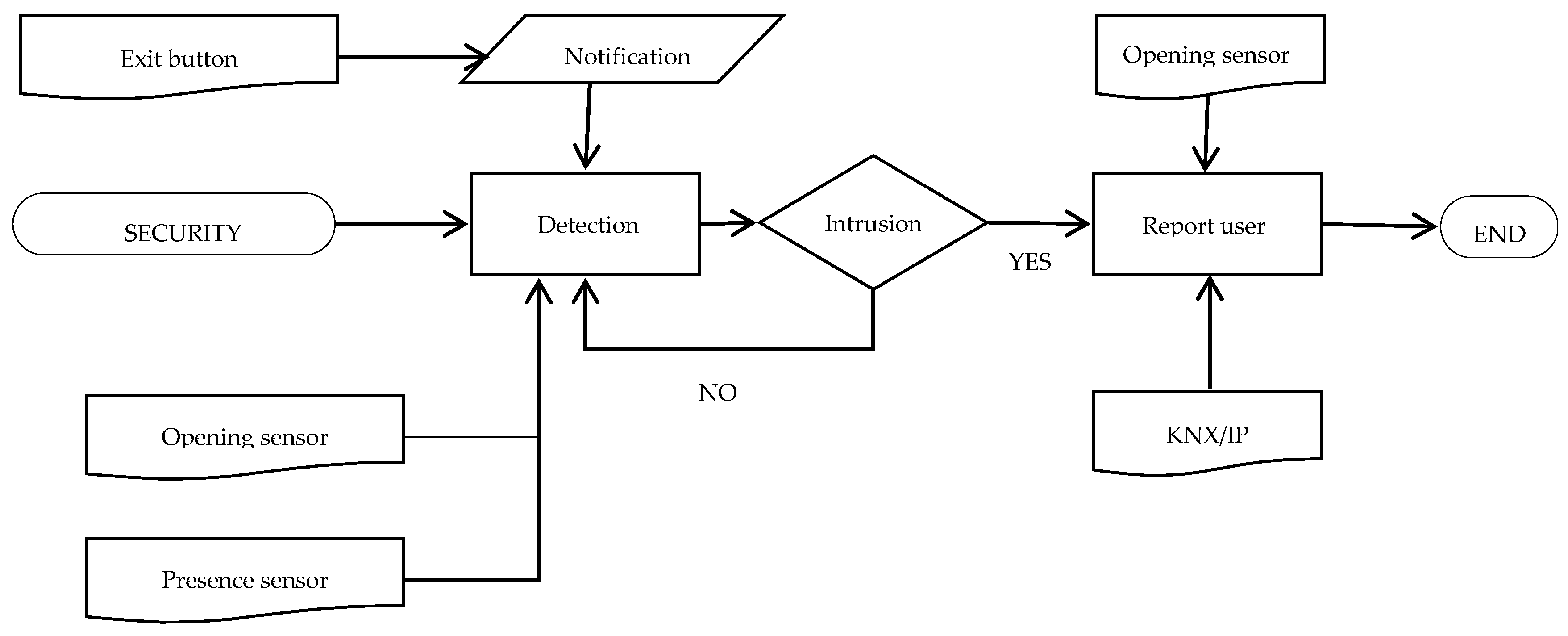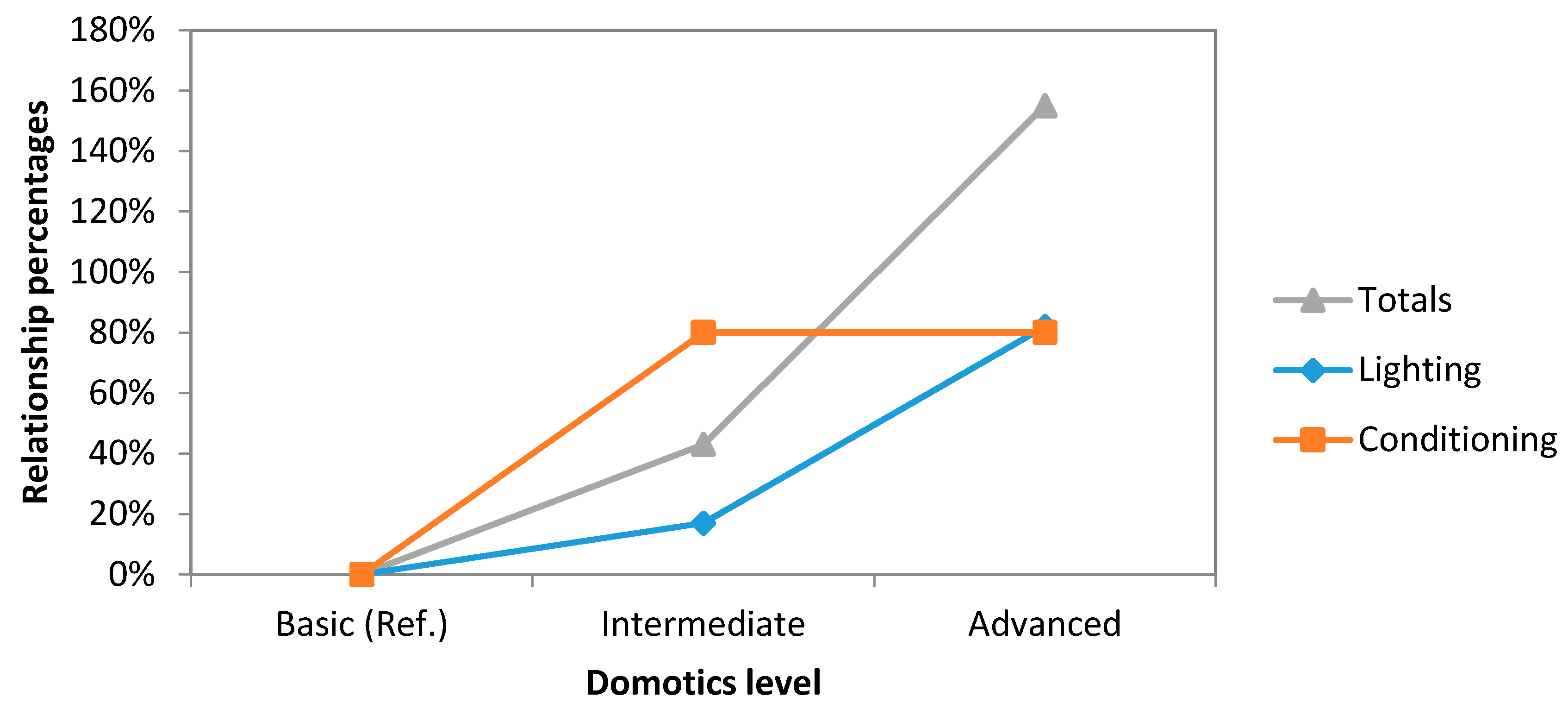1. Introduction
Usually, in the building sector, it is forgotten that the right functioning of a building does not exclusively depend on its distribution, constructive features or facilities. Actually, the most important factor is the way the building is used.
In this field, domotics play a vital role, getting the most of its facilities and constructive features. The domotics concept, as home automation, develops new systems that are able to automatize common functions in households from developed countries, like electrical facilities management, audiovisual systems,
etc. However, currently, there is another concept related to domotics, considered the next step in this area. Smart house concept, apart from home automation, includes central data control of the elements of the system [
1].
Domotics is an essential part of the future of building sector, in which some new services and comforts will be integrated in households. Nowadays, this automation is becoming very important for building energy efficiency, and reducing energy consumption [
2] and CO
2 emissions. These facts are demonstrated in the study of Ippolito [
3], in which the certification level is improved, according to EN15217 standard [
4].
One of the cornerstones in which more efforts are being carried out, is energy efficiency, including making passive systems into active systems, regulating demand, and adapting these systems to the usage of the building [
5]. In fact, in some cases, consumption peaks have been decreased by 46% [
6]. There is hope that these systems will be more affordable, while maintaining their efficiency [
7].
Furthermore, we should not forget that these systems produce intangible benefits for the user. Feeling protected against theft, preventing installation failures, and increased comfort level because of the control of environmental variables are added to energy efficiency benefit with the consequent economic savings.
These systems are objects of continuous improvement, making Home Building Automation System (HBAS) or Building Automation System (BAS) more reliable and robust. In addition, model-based and interactive simulations have been developed [
8]. Another example is the inclusion of wireless technologies like ZigBee or 6LoWPAN, favoring their interoperability [
9].
The inclusion of more and better sensors improves the ability of the system to adapt to the environment and promote the requirements for keeping desired conditions, using a minimum of energy for that performance. Examples might include the inclusion of rain, solar radiation (direct or diffuse), and humidity or wind sensors, among others [
10].
On the other hand, from the user´s point of view, many different services have been created. Internet Protocol Television (IPTV) services [
11] or Android supported scalable home automation systems [
12] are two examples. Moreover, some studies are focused on creating systems that help dependent people, including elderly people, such as the low-cost system by Dasios
et al. [
13] or the security and comfort system from Carpio
et al. [
14]. Other systems are capable of gathering data via the Internet from public Application Programming Interfaces (APIs) [
15]. It is also important to include multi-agent platforms such as PANGEA, used in the work of Villarubia
et al. [
16].
More in general, greenhouses are a good example. In them, climatic conditions control is essential for the installation’s function and automatic devices are proving to be very useful [
17].
Many technologies are used in domotics area, creating a worrying heterogeneity in this area [
18]. Among the various domotics technologies, there are two manufacturers that are more representative because of their major contribution to the area, LonWorks, prevailing in North America, and Konnex (KNX) in Europe. There are a great number of works based on KNX technology that demonstrate its great utility in home data gathering [
19]. Moreover, a KNX system can link the city in which it is situated to its resources management system [
20].
In this work, a domotics system implementation in a flat located in Galapagar (Spain) based on KNX technology is studied [
21].
To create a more detailed study, three systems have been implemented to achieve each level of home automation specified in UNE-CLC/TR 50491-6-3:2013 IN [
22]. Furthermore, we also designed and installed two independent modules compatible with the above-mentioned systems, a security subsystem and a system related to technical alarms.
The aim of this work is to carry out a viability study of each KNX system level for small apartments. This viability is studied in regard to economic, environmental and energy decisions. Moreover, we have gathered data about energy savings of each system and they have been compared according to the three mentioned areas. We have also simulated with SeeTool® software the results of two more real small apartments (Barcelona and A Coruña) with the same orientation located in different climate zones.
For this purpose, and after implementation of these systems in the flat, a quantitative analysis of energy and economic variables has been carried out as well as a second qualitative study made by means of satisfaction surveys that contain comfort and security questions, after the user had been living together with the systems.
Based on these two analyses, we present several conclusions about the influence of each system in user’s life and the energy and economic savings these systems have resulted in.
2. Materials and Methods
2.1. Subject of Research
We have designed and installed a home automation in a flat located in Galapagar (Spain). This flat has a north orientation and consists of 67 m2 usable space over a 79 m2 constructed area, distributed in several rooms: a living room-kitchen-hall (26.80 m2), a master bedroom (12.29 m2), two additional bedrooms (10.24 and 8.34 m2), a bathroom (3.72 m2), a toilet (1.61 m2), one corridor (3.40 m2) and a terrace (12.24 m2).
2.2. General Features of the Home Automation System
Physical level: In this case, a TP1 wiring type for data transmission was chosen. The choice of a wired system instead of a wireless solution, which is a rising technology, is due to the fact that this flat was to be integrally rehabilitated. This makes the added costs of wiring not so high. Apart from that, wiring solutions are highly reliable and using them, we can eliminate added electromagnetic contamination [
23], which has been increasing for the last years because of the uncontrolled advance of technology. It makes wiring solutions a solution to take into consideration.
Topology: We have chosen a data bus composed of lines and areas joined by line-couplers (LC) and backbone/area couplers. Each line can host 64 devices, and each area can be formed for up to 15 lines. Each line is powered by a 24 V DC power supply, and each one supports 640 mA with a cushioning time of 100 ms.
Network design: Each device in this system consists of a microcontroller with memory. This way, we have achieved a distributed architecture, in which if one device fails, it will not affect the functioning of the whole system. Furthermore, it facilitates possible future expansions of the system. Each device is individually programmed.
Protocol: This system is based on KNX standard because it is an already-tested system and because of its reliability and compatibility with many products from different manufacturers. The information is symmetrically sent by both conductors as an alternating signal superimposed on a 24 V dc current. Likewise, KNX use Carrier sense multiple access with collision avoidance (CSMA/CA) network multiple access method in which carrier sensing is used, but nodes attempt to avoid collisions by only transmitting when the channel is sensed to be clear.
Devices: Each device consists of three elements, bus coupler, which is composed of three memory chips (EPROM, ROM and RAM); an external-physical interface; and an application module.
2.3. Common Elements
Regardless of the home automation level, there are some elements that are common to all systems being implemented in them. The first one is the power supply; it is necessary to generate the needed voltage in each line. The power supplies we have chosen are suitable with uninterruptible supply systems (UPS) in order to meet the line needs. An uninterruptible power supply that consist of a lead-gel battery is also part of our system.
To control our system, we have used a control panel. It consists of a touchscreen with which the user can interact. It is fed from the 230 V mains, allows for updating via USB, and has password protection and remote-LAN programming. Furthermore, it includes the needed coupler for its integration in the system.
A KNX-IP gateway is necessary for providing external communication to the intermediate and advanced level, which allow for accessing the bus remotely. By this access, we have been able to carry out the programming of the system through a Virtual Private Network (VPN) configuration. System maintenance and diagnosis during full operation, and device management, have been carried out by means of InSideControl® software. It requires a 24 V DC power supply and a modem/router Internet connection by RJ45 wire.
For line-main line connections or union of new areas with prior areas, we have installed line couplers. This device allows us to set up, according to some parameters, its behavior as a coupler or booster. This eases the effective range expansion of the bus. This also allows for void filter option to test the system. It has two connection terminals.
Finally, apart from the above-mentioned wire, connection terminals have been used to create branch lines or to connect some devices. To this aim, a product that allows the connection of four pairs with a single 0.6–0.8 diameter connection terminal was chosen.
In the following lines, we have described technical features of each implemented systems by means of tables and flow charts in order to ease the understanding of its function.
2.4. Data Acquisition (DAQ) System
A Data Acquisition (DAQ) system with several data loggers (MICROLITE 8/16), which allow us to capture lots of measures, has been implemented. These data loggers were integrated in all systems installed. The data were gathered every 20 min and once a month, there data are sent to a PC. Later, data are analyzed using several specialized software packages to obtain all the results presented in this paper.
5. Discussion
Two main comparisons have been carried out. The first one (
Figure 6) compares the energy savings produced by the three domotics levels grouping lighting and conditioning consumptions.
Furthermore, in the second (
Figure 7), with the same groups, the relationship percentages between our systems has been compared.
Analyzing these two graphs, it can be noticed that the savings on lighting area have a linear trend while new improvements are made to our system, increasing the level of automation. However, this trend changes in economic area. There exists a higher increase in costs when the system levels up to advanced level from the intermediate one.
With regard to conditioning, its behavior is the same as the previous relation, no change existing between advanced and intermediate level but producing great savings. If we compare the intermediate system with respect to the basic one, the savings are improved by 123%.
As we can see in
Figure 7, investments in installing the intermediate system only increase by 43% when the system levels up from basic system. However, this increase is multiplied by a factor of three if we compare it with the advanced system investment.
In
Figure 8, the comparative graph concerning to energy savings of our three levels of automation related to electricity and heating areas can be found. Electricity area greatly increases on the passage from basic system to the intermediate one. This increase is stopped in intermediate-to-advanced step, reducing the relationship percentage of energy savings by 18%. Heating becomes stagnant at the same step.
If we compare these data and CO
2 emissions (
Figure 9), it is noticed that CO
2 reduction comes from the savings done in electricity area and, especially, in the step from basic to intermediate level.
After we installed the home automation system, several surveys about its energy, economic and environmental impact have been done based on the four people who live in this flat. The results of these surveys show that our system achieves energy savings of 19.88% in lighting and 16.09% in air conditioning per year, as well as a reduction of CO2 emissions of 76.03 Kg/month (basic system). All of this implies economical savings of 300 €/year (basic system), and an amortization of the investment that has been made of 20 years (intermediate system).
It is important to notice that advanced system is not as good as expected. Its results are not much better than intermediate system results, being its implementation costs are 78% higher. Probably, its influence only in lighting area is not worthwhile. In the future, in order to get more economic savings, advanced system should take into consideration new tools in air conditioning area or some others that increase, significantly, these savings.
Apart from measurable factors, there are other not-measurable benefits that the user consider when implementing home automation systems. These are the acquired comfort and security feeling because of the security and technical alarms subsystems.
6. Conclusions
The implemented system in this dwelling offers a great number of objective advantages, having as its mainstay the energy savings, which also lead to economic savings and to a reduction of CO2 emissions, which is, nowadays, so valuable. It is also important to appreciate positively the increase in comfort and security that this system provides to the user.
Intermediate-to-advanced level up increases the costs of the system but there is little added economic savings; thus, the intermediate level is the most adequate for a small apartment typology.
Climatic zones also influence on these savings; thus, apartment location is very important when choosing the best level of the home automation system.
The 20-year amortization, at best, is insufficient to conclude that the system is economically viable. This fact becomes a pending task that we will have to improve in the future to enter individual user market.















